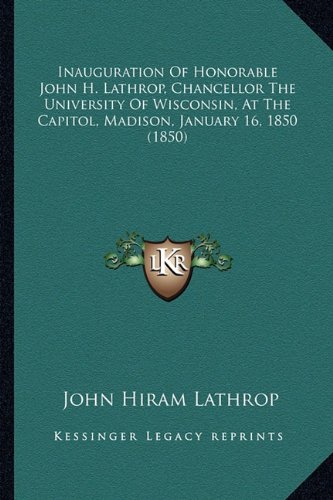Background
John Hiram Lathrop was born in Sherburne, Chenango County, New York. His parents, John and Prudence Elizabeth (Hatch) Lathrop were of Puritan ancestry. His father was a descendant of the Rev. John Lothropp.



(This scarce antiquarian book is a facsimile reprint of th...)
This scarce antiquarian book is a facsimile reprint of the original. Due to its age, it may contain imperfections such as marks, notations, marginalia and flawed pages. Because we believe this work is culturally important, we have made it available as part of our commitment for protecting, preserving, and promoting the world's literature in affordable, high quality, modern editions that are true to the original work.
https://www.amazon.com/Inauguration-Honorable-Chancellor-University-Wisconsin/dp/1166417794?SubscriptionId=AKIAJRRWTH346WSPOAFQ&tag=prabook-20&linkCode=sp1&camp=2025&creative=165953&creativeASIN=1166417794
John Hiram Lathrop was born in Sherburne, Chenango County, New York. His parents, John and Prudence Elizabeth (Hatch) Lathrop were of Puritan ancestry. His father was a descendant of the Rev. John Lothropp.
After preparatory study under a neighboring clergyman, he entered Hamilton College, Clinton, New York in 1815, and two years later was admitted to the junior class at Yale, from which institution he was graduated in 1819.
Lathrop then taught for three years, first in the grammar school at Farmington, Connecticut, and then in Monroe Academy at Weston. From 1822 until 1826 he was a tutor at Yale. Admitted to the bar in the latter year, he opened a law office at Middletown, Connecticut, but soon returned to educational work, in which he now was convinced he should make his career.
He became an instructor in the Military Academy at Norwich, Vermont, and later was principal of the Gardiner Lyceum at Gardiner, Maine. In 1829 he became professor of mathematics and natural philosophy at Hamilton College and six years later was promoted to the Maynard professorship of law, civil polity, and political economy.
Lathrop's career began on March 11, 1841, when, after a six weeks' journey by stage and boat to Columbia, Missouri, he became the first president of the University of Missouri. His task as president was to lead in developing a university for the benefit of which Congress had appropriated land, and to which the citizens of Boone County had voluntarily given from their meager resources $117, 900. The cornerstone of the first university building had been laid July 4, preceding his arrival, but the edifice was not completed until 1843.
His work included overseeing the sale of lands, supervising the erection of buildings, maturing plans for curricula and teaching, and advising the legislature with regard to the nature and needs of a real university. In this work he necessarily faced difficulties arising from lack of funds, and from religious sectarianism and partisan politics. He was embarrassed, too, by the increasing controversy about slavery and could not escape the antagonism of many who knew his acceptance of the doctrine that "all men are born free. "
Although the curators of the University of Missouri desired him to continue as president, he decided in 1849 to accept the chancellorship of the University of Wisconsin, where he again became a pioneer university builder for ten years. Then, after two invitations, he became president of Indiana University. When the University of Missouri was reorganized, he accepted, in 1860, a call to return to this institution as professor of English literature. His welcome was enthusiastic. During the years 1863-65, his title was chairman of the faculty and professor of moral, mental, and political philosophy. He helped to guide the university during the precarious conditions of civil war, and in 1865 he was for the second time officially made president. In the following year he died and was buried in a cemetery near the campus.
Well-grounded in the social philosophy of his time, he believed that education should be practical and that the university should provide training in agriculture and in the various professions and arts. He believed that the profession of education should be as clearly separated from that of theology as the profession of law is separated from that of medicine, and that the remuneration of the successful teacher should be equivalent to that of the successful man in other learned professions.
Deeply religious, but without sectarian bias, he regularly attended and contributed to the support of church services. Late in life he became a member of the Episcopal Church. He said that the ideal professor should be "too intensely American to be partisan, too profoundly Christian to be sectarian. " This ideal was largely realized in his own life.
Lathrop was the pioneer in higher education in the Middle W. He was credited with laying the foundations for the university's first century. During his tenure as chancellor, he established the academic setting at the university of Wisconsin and he recommended the university's seal and motto, "Numen Lumen. "
(This scarce antiquarian book is a facsimile reprint of th...)
Lathrop was a man of attractive personality, wide scholarship, and ability both in teaching and in educational administration.
Lathrop had married, in 1833, Frances E. Lothrop of Utica, New York.
